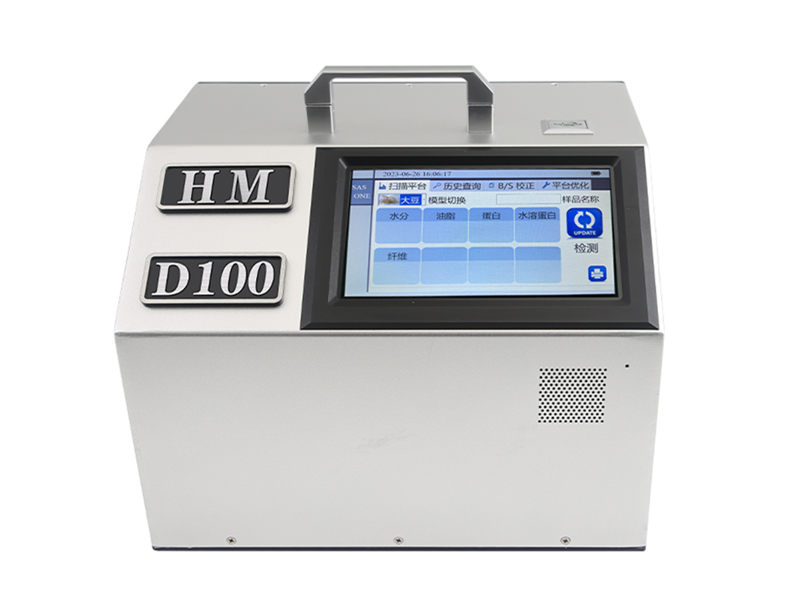How Soybean Protein Analyzers Achieve Rapid Multi-Index Detection?
Article Source: Hengmei Technology Release time:2025-09-29 16:56:27
As one of the important grain and oil crops, soybean's protein content directly determines its economic value and application fields. In industries such as food processing and feed production, soy protein content is a key indicator for pricing and quality grading. The soybean protein analyzer is a portable device based on near-infrared spectroscopy technology, which can complete non-destructive testing of multiple indicators of soybeans within 1-2 minutes, providing real-time decision support for various links in the soybean industry chain.

Working principle and technical analysis
The soy protein analyzer adopts near-infrared diffuse reflectance spectroscopy technology (900-1700nm), and its working principle is based on the following scientific basis:
Molecular vibration absorption: Proteins, oils, and other components in soybeans have characteristic absorption peaks in the near-infrared region
Spectral feature extraction: 24 bit high-precision spectral acquisition system captures the subtle optical features of the sample
Chemometric modeling: converting spectral data into indicators such as protein content through established quantitative models
Testing process:
Put an appropriate amount of soybean sample into the sample pool
The instrument emits near-infrared light and collects diffuse reflectance spectra
Built in algorithm for real-time analysis of spectral features
Output protein, oil, moisture, water-soluble protein, fiber and other indicators content
Automatic storage or transmission of data to the management system
Technical advantages and performance characteristics
1. Convenient operation design
One click detection: No professional training required, just start with one click after placing the sample to obtain results
Multi environment adaptation: working temperature range of 5-55 ℃, humidity<80% RH, suitable for various on-site conditions
Self checking function: Built in self checking module ensures reliable instrument status and avoids erroneous detection
Data interconnection: supports wireless data transmission, facilitating integration with management systems
2. Testing performance parameters
According to rigorous testing, the key performance indicators of the soy protein analyzer are as follows:
Detection speed: ≤ 2 minutes/sample (multiple indicators synchronized)
Detection accuracy:
Protein content error ≤ 0.5%
Oil content error ≤ 0.3%
Moisture content error ≤ 0.2%
Light source lifespan: 20000 hours (approximately 7 years of use based on 8 hours/day)
Stability: The coefficient of variation for 100 consecutive tests is less than 1.5%
Application scenarios and solutions
1. Main application areas
Soy protein analyzer is applied in various links of the industrial chain:
Acquisition process: on-site rapid graded pricing; Eliminate human quality disputes; Establish supplier quality records
Warehouse management: establishment of quality standards for incoming goods; Quality monitoring during storage; Quality review of outgoing goods
Processing and production: optimization of raw material ratio; Quality control in the production process; Finished product quality verification
2. Industry pain point solutions
For typical problems in the soybean industry, the soybean protein analyzer provides professional solutions:
Pain point 1: Inefficient detection during the acquisition season
Solution: Vehicle mobile detection, on-site results within 2 minutes
Pain point 2: Difficulty monitoring quality changes during storage
Solution: Regular portable testing to establish a quality change curve
Pain point 3: Inaccurate raw material ratio in processing
Solution: Quickly detect each batch of raw materials and optimize the feeding ratio
The successful application of soybean protein analyzer as near-infrared detection technology in the soybean field has solved the industry problem of low efficiency and high cost of traditional detection methods. Its portability, speed, and multi index detection capability make it an important testing tool for quality control in the soybean industry chain.
Address of this article:https://www.kjhm.net/news/782.html
 Related News
Related News
-
12 / 2024-11
Unlock the Secrets of Photosynthesis with Portable Photosynthesis Meter.
Learn more
-
11 / 2024-05
Pesticide Residue Detector: An Important Tool For Safeguarding Food Safety.
Learn more
-
09 / 2024-09
The Role Of Soil Respirometer In Agricultural Management.
Learn more
-
29 / 2024-10
Unleash the Power of Soil Respiration Analysis with HM-TH2.
Learn more



 Current
Location:
Current
Location:





